Shingles
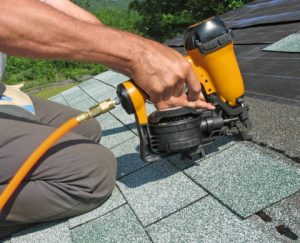 Asphalt shingles are by far the most popular choice of roofing material. Why? Well, simply put, they’re usually the least expensive option available. That’s reason enough, for some builders and some homeowners, to tack asphalt shingles to their roofs. Here are some other pros and cons that come along with an asphalt shingle installation:
Asphalt shingles are by far the most popular choice of roofing material. Why? Well, simply put, they’re usually the least expensive option available. That’s reason enough, for some builders and some homeowners, to tack asphalt shingles to their roofs. Here are some other pros and cons that come along with an asphalt shingle installation: The Pros
Asphalt shingles, like every other shingle material, are designed to perform. With proper care, maintenance, and replacement, your asphalt shingles will protect your home just as well as any other material. In addition, asphalt shingles come in a variety of brands, so you can select a shingle that looks good, performs as you’d like, and lasts as you’d expect. Finally, asphalt shingles are a breeze to install. Due to their weight, and the ease of throwing in roofing nails, a full roof can be completed in a number of hours. Asphalt shingles also don’t require the structural support that may be necessary for heavier materials, like slate.
The Cons
Asphalt shingles don’t last as long as other shingles. You can expect your shingles to need replacing every 12 to 17 years, depending on the type of shingle in use, as well as the weather (shingles can take a beating from wind and precipitation throughout the year). On top of that, asphalt shingles are more prone to damage than other materials. Shingles can become damaged by freezing temperatures or extreme heat. Asphalt shingles also aren’t the most environmentally friendly option available. Since shingles are created out of petrochemicals, they’re difficult to produce. Old shingles often aren’t properly recycled, either (Don’t worry! We recycle old shingles.) which can compound the problematic environmental impact.
Wooden Shakes
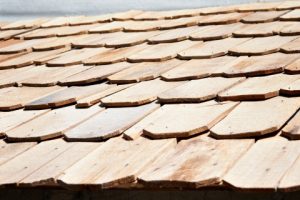 Wooden shakes just look good. They give a home a rustic appeal, and they’re just as functional as other roofing materials on the market.
Wooden shakes just look good. They give a home a rustic appeal, and they’re just as functional as other roofing materials on the market. The Pros
Wood shakes are a renewable roofing material, and they’re one of the most environmentally friendly options. Since these shakes are simply crafted out of wood, a shake can be prepared with a few cuts of a blade. In addition, shakes actually outlast man-made shingles — wooden shakes can last two decades or more. And when a shake is at its end of life, it can be recycled and composted, instead of tossed in the landfill. Once again, wooden shakes just look good. It’s pleasing to see cedar shakes capping off a stone or brick home (or any home for that matter).
The Cons
Wooden shakes take a bit more time and care to install than their asphalt counterparts; and they require more maintenance throughout their lifetime. Shakes can crack, they can discolor, they can be infested by insects, and they can promote mold and moss growth (which could also be a problem for your attic — which you want to keep free from moisture and mold). In addition, wooden shakes cost more than asphalt shingles; the installation cost is higher (since it takes more skill and time), and the cost of the shakes themselves is higher (the price can be three-fold or more).
Slate & Slate Composite
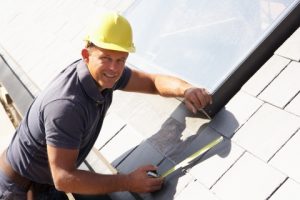 Slate may be considered the most beautiful roofing material, but it’s certainly the most difficult to install. Let’s weigh the rest of the pros and cons that you can expect from slate and slate composite roofing...
Slate may be considered the most beautiful roofing material, but it’s certainly the most difficult to install. Let’s weigh the rest of the pros and cons that you can expect from slate and slate composite roofing... The Pros
Slate (and slate composite) roofs offer long-lasting protection for a home, and they require very little maintenance. Slate tiles can last well over a century (some tiles have lasted for 175 years). On top of that, slate tiles simply look great. For these two reasons, installing a slate tile can boost the value of a home, so you may retain much of the cost of a slate roof if you’re ever going to put your home on the market. And, since your roof won’t need much maintenance, and it won’t require replaced materials, you can save money over time. Your home will look beautiful, and you can rest assured that you have one of the best roofing materials protecting your abode.
The Cons
Slate (and slate composite) roofs take a huge effort to install. Since slate is heavy, it’s crucial to make sure that your roofing structure can handle the extra weight (a slate tile roof can literally add tons of weight to the structure of your home). That makes the cost of installation higher. Like wood shakes, the cost of slate tiles is also higher. In fact, slate tiles can cost 20 times as much as some asphalt shingles, for the same coverage. OK, and this may sound like a contradiction with the aforementioned statement about durability, but slate tiles are actually quite fragile. While slate can last for hundreds of years, a bit of weight applied in the wrong way (e.g. someone walking over your rooftop to get that kite that’s caught on the chimney) can crack your slate tiles, and that means that you’ll have to replace them. What’s worse, is that slate tiles (unlike composite tiles) are often one-of-a-kind (i.e. they come in a “lot” all pulled from the same quarry — so they look similar). If you have a few cracked tiles, you may have to replace them with a different colored stone. It’s wise to purchase a few extra tiles to keep just in case someone does decide to walk across your roof.
Metal
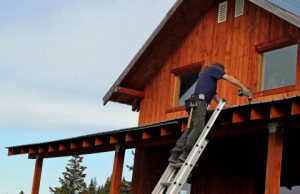 Metal is a unique material for roofing. Unlike all other materials, metal can be applied in large sheets, and of course, it has a distinct look.
Metal is a unique material for roofing. Unlike all other materials, metal can be applied in large sheets, and of course, it has a distinct look. The Pros
First things first, metal roofs are quite durable. While metal won’t outlast slate, it outlasts wood shakes and asphalt. Metal roofs can last between two and five decades, and it’s pretty common to find metal roofing that is backed by a 30-year warranty. Metal is also quite lightweight, so you won’t have to make sure that your roof structure can support the tons of tile that you might otherwise use. Since metal roofs are lightweight and because they come in large sheets, a full installation can be swift. Metal roofs are also fire resistant (unlike wood shakes and some asphalt roofs), and they can improve your home’s efficiency in the summer (because they reflect light away from the surface of your home). Metal is an ideal material for low-slope roofs, since leaking is less of a concern. Plus, the smoothness of metal roofs is ideal in snowstorms, since they can shed snow with a bit of warmth or with a gentle push.
The Cons
Metal roofs aren’t efficient in the winter, due to their low R-value (which measures the insulating qualities of a material). However, you can compensate for this shortcoming with attic insulation and an air pocket between your metal roof and the rest of your roof envelope. Metal roofs are also notoriously noisy (you’ll certainly hear a rainstorm, and a hailstorm can be downright noisy). However, some cherish the noise of a storm, and others choose to insulate their attics to cut the noise levels.
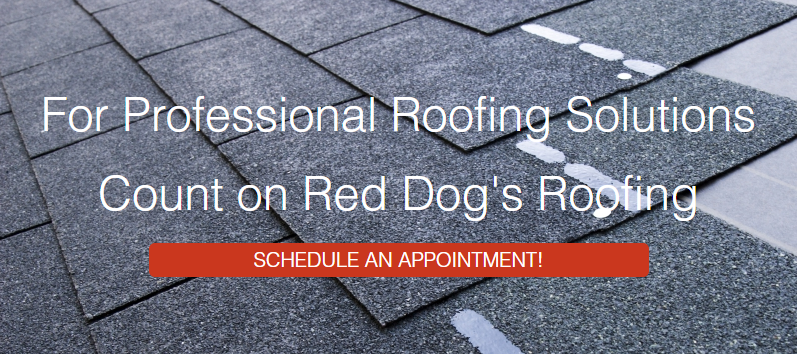
Our Professional Roofing Solutions
Here at Red Dog’s Roofing, we provide all of the above roofing solutions. If you’re uncertain about the best material for your roof and situation, get in touch with us — we’ll discuss your options and help you to settle on the ideal material for your home. And when you’re ready to get started, go ahead and schedule an appointment! Red Dog’s Roofing provides roofing installation and maintenance services to folks throughout Massachusetts, including Fitchburg, Leominster, Gardner, Westminster, Lunenburg, Lancaster, Ashburnham, Princeton, and Sterling.Tags
Subscribe to Red Dog's Roofing's Blog





Comments